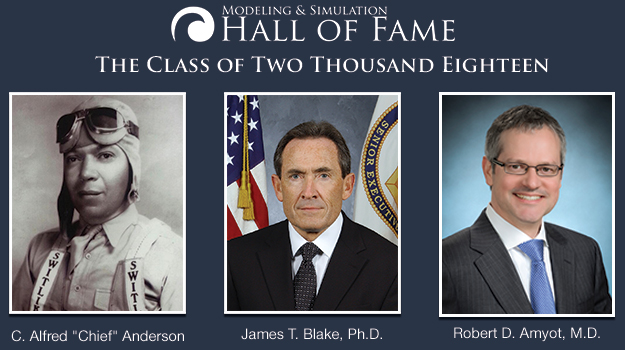
~IMMEDIATE RELEASE
Contact: Dolly Rairigh Glass
(407) 797-7851, dolly@mycapitalcommunications.com
May 29, 2018 (Orlando, Fla.) — National Center for Simulation recently announced it will induct three new members to the National Center for Simulation Modeling and Simulation Hall of Fame on Tuesday, June 12. The 2018 class includes Robert D. Amyot, M.D., president of CAE Healthcare; C. Alfred “Chief” Anderson, Tuskegee Airman and first chief flight instructor for the Tuskegee Institute’s Army Air Corps; and James T. Blake, Ph.D., retired Army colonel and the former U.S. Army Program Executive Officer for Simulation, Training and Instrumentation.
“We celebrated our first inductees into the Modeling and Simulation Hall of Fame in 2014. Since then, it has been our privilege to recognize a number of passionate pioneers who have made significant contributions in all facets of modeling and simulation,” said Lt. Gen. (ret) Thomas L. Baptiste, NCS president and CEO. “This year’s distinguished candidates are no different – they come from varying disciplines and even different eras, but they have left a legacy in simulation for future generations.”
Dr. Robert D. Amyot is a pioneer in medical simulation, as well as a cardiologist, clinician-researcher, inventor and president of CAE Healthcare. After many years as a successful, highly skilled clinician, researcher and professor, Amyot experienced a dramatic moment when he realized that learning and practicing procedures on live patients was insufficient, and even worse, dangerous. Finding a lack of training tools for echocardiography, he developed the virtual reality Vimedix ultrasound simulator with his partners and obtained a patent for his invention. He sold his first commercial Vimedix simulator to Beth Israel Deaconess Medical Center in Boston where it is still being used for training and research today.
After several years as an entrepreneur, he sold his company to CAE Healthcare and became the chief medical officer, then president, while quickly gaining recognition as an advocate for simulation-based education in healthcare to improve patient safety. Today, he is expanding his message, meeting with medical societies and associations to promote simulation-based training standards and ongoing competency assessments for clinicians.
C. Alfred “Chief” Anderson was the first chief flight instructor for the Tuskegee Institute’s Army Air Corps civilian pilot training program. A man before his time, and known as a prankster, Anderson’s passion for flying put Tuskegee, Alabama, on the map, forever known as the “birthplace of black aviation.” One of the most famous pictures in aviation history, particularly in the remarkable history of the Tuskegee Airmen, was in March 1941 when First Lady Eleanor Roosevelt met Chief Anderson during her orientation to the Civilian Pilot Training Program at “Airport Number One.” She told him she heard that “colored people can’t fly airplanes, but that apparently he could.” She then said, “I’m going to have to take a flight with you.”
Despite the concerns of her Secret Service detail who were attempting to contact the president, Chief was not about to turn down the First Lady. They took off together for a 40-minute flight. Once they landed, Mrs. Roosevelt said, “Well, you can fly alright.” The rest is Tuskegee Airmen world-changing history.
Dr. James T. Blake, a soldier, scientist, Army leader, and noted expert in modeling, simulation and training, had a passion for improving soldier performance throughout his 50-year career. When he joined the U.S. Army Research Laboratory’s Advanced Simulation and High Performance Computing Directorate, serving at Georgia Tech and Aberdeen Proving Ground, then ultimately serving as the Deputy Directorate Executive, Blake was pivotal in assuring the newly organized Army Research Laboratory was positioned to provide comprehensive research support in the use of simulation for training.
During this period he advised Army leaders on the design and execution of the Synthetic Theater of War-Europe (STOW-E), an exercise that became a critical milestone for demonstrating that modeling and simulation technology could be scaled to support the training of a large force located in multiple locations. The exercise was seamlessly integrated in a common synthetic battlespace involving constructive, live, and virtual domains.
He also established the Uniformed Army Scientist Program, and served as the military’s senior Uniformed Army Scientist, interacting with other uniformed scientists around the country — many of whom became involved in modeling and simulation throughout their military careers and later influenced M&S technology in industry. The impact he had on this group of scientists is immeasurable.
The Hall of Fame induction ceremony will take place at the Orange County Convention Center, south concourse, where the NCS Modeling and Simulation Hall of Fame “wall” is on permanent display.
About National Center for Simulation
NCS is a non-profit trade association supporting and expanding the modeling and simulation community, and is committed to promoting modeling and simulation technology expansion; education and workforce development, and providing business development assistance to its members.
www.simulationinformation.com
###